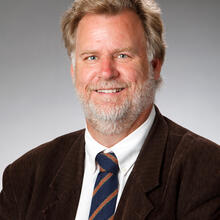Heaven-Sent
Paul says of Jesus in 1 Cor 15:45, “Thus it is written, ‘the first man, Adam, became a living being’; the last Adam became a life-giving spirit.” Luke Timothy Johnson draws on this verse when he describes the ascension of Jesus, saying that “the ‘withdrawal’ of Jesus is not so much an absence as it is a presence in a new and more powerful mode: when Jesus is not among them as another specific body, he is accessible to all as life-giving spirit.”
While it is true that Jesus is now with us “as live-giving spirit,” even after his ascension, he remains a particular person, both God and man. While he is present in a new and more powerful mode, Jesus is absent in a profound way, which is why we yearn for his return. At the ascension Jesus does not cease to be the one who came to earth, who was raised up and who will come again in glory to judge both the living and the dead. This is the same risen Lord who appeared after his ascension to Paul. Paul asked in response to his experience, “Who are you Lord?” “I am Jesus, whom you are persecuting” (Acts 9:5).
At the same time, we must acknowledge the constant presence of Jesus in the church and his accessibility to all of us. It is through the Eucharist that we know Jesus intimately now and as a foretaste of heaven; it is in the church, the body of Christ, of which he is the head, that he is truly present in our midst. The tension between Jesus’ presence and absence exists also in our conception of the ascension. The ascension is described in Luke and Acts using the cosmological language of a three-tiered universe, in which Jesus floats up into heaven—an image long ago exploded by scientific views of the cosmos. But if we speak of the imagery of the ascension as a metaphor, this should not divert us from the reality of the event: Jesus in his particularity is in heaven with God.
In asserting Jesus’ identity and real existence, we support the hopeful anthropology of Christianity against gnostic devaluations of personal identity and the goodness of the body. As the risen Jesus exists even now as Lord, we too will one day be raised up as physical beings with personal identity. We will not be subsumed in a divine nothingness; we will not lose our individuality. Yet a radical transformation will occur between who we are now and who we will be in heaven.
There might be some people who withdraw from the notion of heaven as a “place,” but Christianity does not reduce the afterlife to psychological projection or childish wish fulfillment. Christianity speaks of the existence of these places and those who inhabit them as real. Such notions are not simply metaphors, but they call on us to move from our concrete notions of spirit and matter to a more subtle if unclear notion of the nature of ultimate reality. The reality of the ascension is at the heart of the Christian life and the Christian hope. It is the point at which the church begins to take shape as eucharistic community—that is, centered on koinonia, fellowship or communion, and the Eucharist. It is a sign of the hopeful and joyful anthropology of the church, which promises not a melting away of our individuality, but the continuation of our identity as radically transformed beings in God’s presence. And it is the event that makes us aware of Jesus’ presence and his absence. It is, finally, the promise of Jesus’ return in his particularity as the risen Lord: the one who became incarnate on our behalf, who died on the cross for us, who was raised from the dead and sits at the right hand of the Father and who will return to be pre- sent with us.
This article also appeared in print, under the headline “Heaven-Sent,” in the May 6, 2013, issue.







